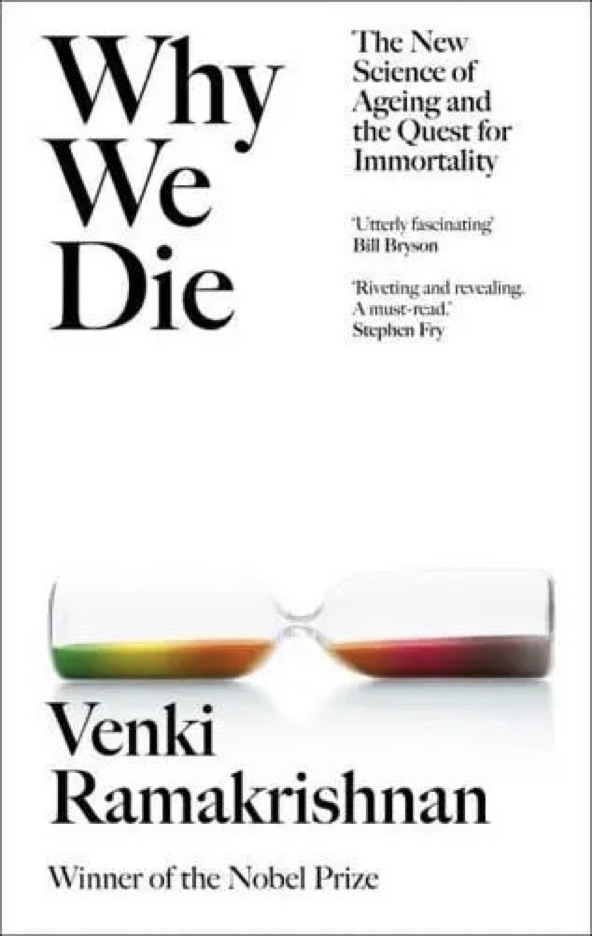
This scientific exploration by the Cambridge Nobel laureate molecular biochemist is not a duplication of Sherman Nuland’s 1993 classic How We Die, although there is considerable overlap. Citing Gompertz’s Law that probability of mortality increases exponentially with age and the relationship of body size to longevity across species, he focuses early on on exceptions. The question as to whether or not there is an inevitable upper limit to human longevity is bitterly disputed.
The author uncritically accepts that Jeanne Calment was the oldest documented human at 122, but a detailed study in The New Yorker in 2022 concluded that her daughter Yvonne assumed her identity when she died in 1934. And they are not alone.
The very detailed discussion of DNA, chromosomes, mutations and the tumour suppression gene p53 and their roles in aging were just understandable to me with a scientific education, but will probably just confuse those readers from the arts. And considering a gene as a sentient being that senses and believes is a poor metaphor, but perhaps necessary. I was aware of the role of telomere shortening in cell senescence, but not the science of trying to lengthen it with the attendant increased risk of cancers, at least experimentally. And I was aware of DNA methylation as a means of turning off expression of genes, but not of the largely reverse effect of histone acetylation both seemingly important determinants of aging and modifiable by environmental factors.
The chapter on cellular debris recycling is easier to understand with its very apt metaphors about personal and municipal recycling. The author is more cautious about recommending any of the various intermittent fasting regimens to prolong life than many others, pointing out that what we eat, when we eat, maintaining a healthy weight, exercise, and how well we sleep may be more important. The convoluted and confusing study of rapamycin and its possible effect as an anti-aging agent confused me even as one who prescribed it extensively to inhibit organ rejection. The supposed benefits of metformin in non-diabetics as a life prolonging agent seems iffy. There is no mention of the possible beneficial effect of supplementing the amino acid taurine to improve quality and possibly quantity of life, in spite of some strong hints that it may do so. Confession time: I do consume supplements of taurine, even though there is no hard evidence of benefit. It is cheap and at least it seems to be harmless, and it was recommended by a friend and former colleague, whom I trust. If nothing else, it is a safe placebo. It would be easy to do a large double blind study of it’s effects, but no big pharmaceutical is likely be interested as it is unlikely to be profitable. Similar claims, with what seems to me to be less evidence, are made by the thriving health food industry for a huge number of other supplements, including nicotinamide ribose.
The chapter on worms as a fit subject to study aging and longevity is confusing with only tentative conclusions, particularly about the touted benefits of resveratrol found in red wine. There is nothing here to hint at the possibility of immortality. Likewise, the chapter on reactive oxygen species, antioxidants and free radicals, along with the role of decreasing mitochondrial damage and repair is confusing and beyond comprehension for many readers, including me, and ends up with no firm conclusions.
The chapter on cryogenics and trans- humanism is refreshingly clear and trashes a huge amount of dreamy research. “These enthusiastic rich billionaires are mostly middle-aged men (sometimes married to younger women) who made their money very young, enjoy their lifestyles and don’t want the party to end. When they were young, they wanted to be rich, and now that they are rich, they want to be young. But youth is the one thing that they cannot buy, so, not surprisingly, many of the celebrity billionaires – such as Elon Musk, Peter Thiel, Larry Page, Sergei Brin, Yuri Brenner, Jeff Bezos, and Mark Zuckerberg, have all expressed an interest in anti-aging research. And in many cases they are funding it. The one exception is Bill Gates, who realistically believes that the best way to improve overall life expectancy remains addressing the serious health care inequalities in the world.”
It was disappointing to note that we are still increasing the period of morbidity before dying rather than decreasing it. I have no wish to obtain immortality but to paraphrase the anti-aging guru Rick Klausner, I would like to die young in my sleep after a long life, perhaps at 95 or 100. But that seems increasingly unlikely- I am much more likely to have a long period of severe morbidity, before welcoming death.
In the last chapter, Ramakrishnan carefully documents the major downsides for society if we were to achieve anything approaching immortality. Ultimately it is a selfish goal.
This book documents an active area of research, but is dense and loaded with scientific data that many readers cannot realistically be expected to understand.
6.5/10
Thanks, Book Browse.
Cam